1997 HONDA ODYSSEY ECU
[x] Cancel search: ECUPage 4 of 241
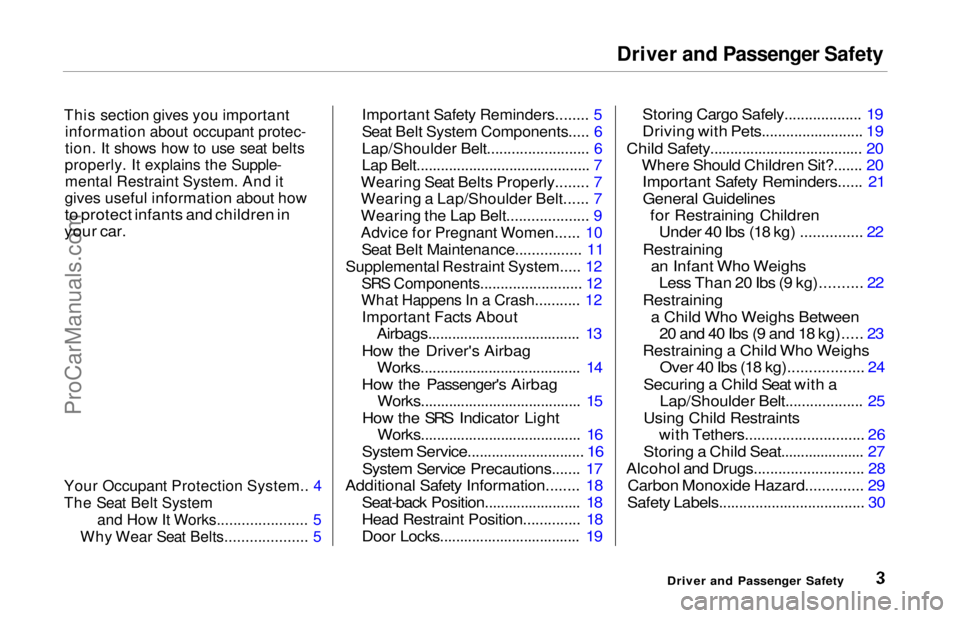
Driver and Passenger Safety
This section gives you important
information about occupant protec-
tion. It shows how to use seat belts
properly. It explains the Supple-
mental Restraint System. And it
gives useful information about how
to protect infants and children in
your car.
Your Occupant Protection System.. 4
The Seat Belt System
and How It Works...................... 5
Why Wear Seat Belts.................... 5
Important Safety Reminders........ 5
Seat Belt System Components..... 6
Lap/Shoulder Belt......................... 6
Lap Belt........................................... 7
Wearing Seat Belts Properly........ 7
Wearing a Lap/Shoulder Belt...... 7
Wearing the Lap Belt.................... 9
Advice for Pregnant Women...... 10
Seat Belt Maintenance................ 11
Supplemental Restraint System..... 12
SRS Components......................... 12
What Happens In a Crash........... 12
Important Facts About
Airbags...................................... 13
How the Driver's Airbag Works........................................ 14
How the Passenger's Airbag Works........................................ 15
How the SRS Indicator Light Works........................................ 16
System Service............................. 16
System Service Precautions....... 17
Additional Safety Information........ 18
Seat-back Position........................ 18
Head Restraint Position.............. 18
Door Locks................................... 19 Storing Cargo Safely................... 19
Driving with Pets......................... 19
Child Safety...................................... 20 Where Should Children Sit?....... 20Important Safety Reminders...... 21
General Guidelines for Restraining Children Under 40 Ibs (18 kg) ............... 22
Restraining
an Infant Who WeighsLess Than 20 Ibs (9 kg).......... 22
Restraining
a Child Who Weighs Between 20 and 40 Ibs (9 and 18 kg)..... 23
Restraining a Child Who Weighs Over 40 Ibs (18 kg).................. 24
Securing a Child Seat with a Lap/Shoulder Belt................... 25
Using Child Restraints with Tethers............................. 26
Storing a Child Seat..................... 27
Alcohol and Drugs........................... 28 Carbon Monoxide Hazard.............. 29
Safety Labels.................................... 30
Driver and Passenger SafetyProCarManuals.comMain Menu s t
Page 5 of 241
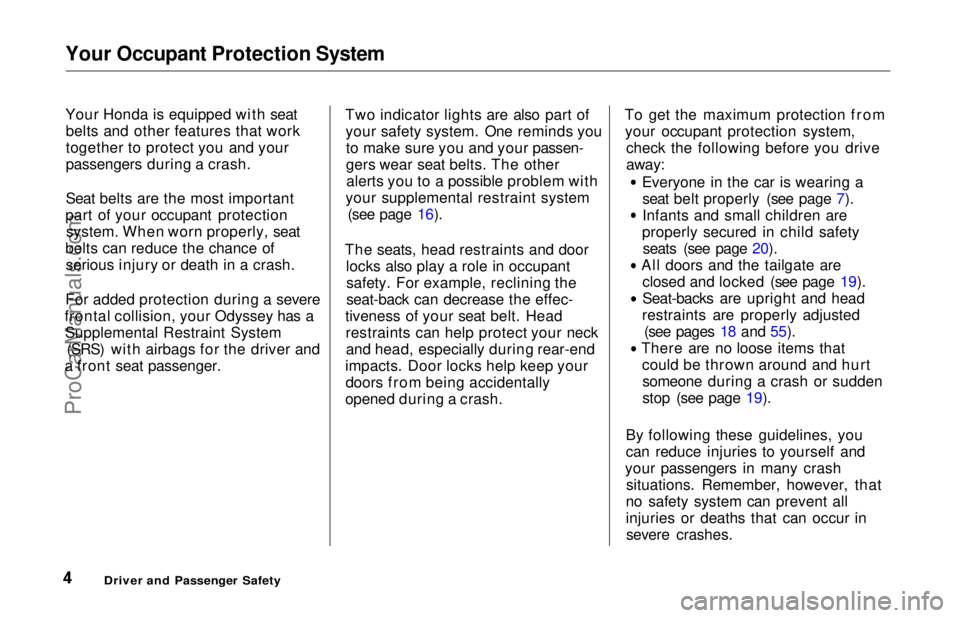
Your Occupant Protection System
Your Honda is equipped with seat
belts and other features that work
together to protect you and your
passengers during a crash.
Seat belts are the most important
part of your occupant protection system. When worn properly, seat
belts can reduce the chance of serious injury or death in a crash.
For added protection during a severe
frontal collision, your Odyssey has a Supplemental Restraint System (SRS) with airbags for the driver and
a front seat passenger. Two indicator lights are also part of
your safety system. One reminds youto make sure you and your passen-
gers wear seat belts. The otheralerts you to a possible problem with
your supplemental restraint system (see page 16).
The seats, head restraints and door locks also play a role in occupantsafety. For example, reclining the
seat-back can decrease the effec-
tiveness of your seat belt. Head restraints can help protect your neckand head, especially during rear-end
impacts. Door locks help keep your doors from being accidentally
opened during a crash. To get the maximum protection from
your occupant protection system, check the following before you drive
away:
Everyone in the car is wearing a
seat belt properly (see page 7). Infants and small children are
properly secured in child safety seats (see page 20). All doors and the tailgate are
closed and locked (see page 19). Seat-backs are upright and head
restraints are properly adjusted (see pages 18 and 55). There are no loose items that
could be thrown around and hurtsomeone during a crash or sudden
stop (see page 19).
By following these guidelines, you
can reduce injuries to yourself and
your passengers in many crash situations. Remember, however, that
no safety system can prevent all
injuries or deaths that can occur in severe crashes.
Driver and Passenger SafetyProCarManuals.comMain Menu Table of Contents s t
Page 7 of 241
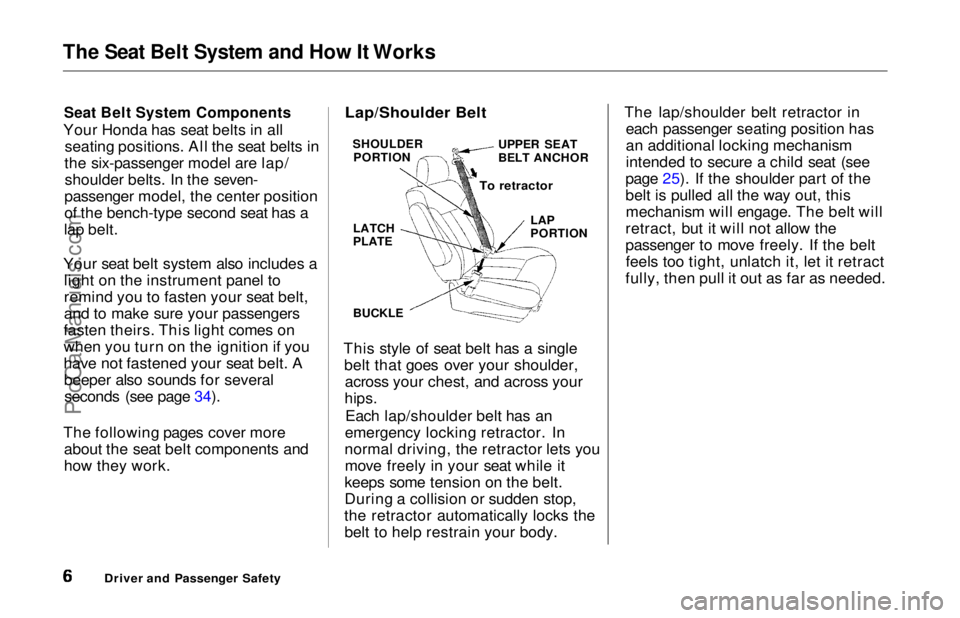
The Seat Belt System and How It Works
Seat Belt System Components
Your Honda has seat belts in all seating positions. All the seat belts in
the six-passenger model are lap/ shoulder belts. In the seven-
passenger model, the center position
of the bench-type second seat has a
lap belt.
Your seat belt system also includes a light on the instrument panel to
remind you to fasten your seat belt,
and to make sure your passengers
fasten theirs. This light comes on
when you turn on the ignition if you
have not fastened your seat belt. A beeper also sounds for severalseconds (see page 34).
The following pages cover more about the seat belt components and
how they work.
Lap/Shoulder Belt
This style of seat belt has a single belt that goes over your shoulder,across your chest, and across your
hips.
Each lap/shoulder belt has an
emergency locking retractor. In
normal driving, the retractor lets you move freely in your seat while it
keeps some tension on the belt.
During a collision or sudden stop,
the retractor automatically locks the belt to help restrain your body. The lap/shoulder belt retractor in
each passenger seating position has
an additional locking mechanism
intended to secure a child seat (see
page 25). If the shoulder part of the
belt is pulled all the way out, this mechanism will engage. The belt will
retract, but it will not allow the
passenger to move freely. If the belt feels too tight, unlatch it, let it retract
fully, then pull it out as far as needed.
Driver and Passenger Safety
SHOULDER
PORTION UPPER SEAT
BELT ANCHOR
To retractor
LAP
PORTION
LATCH
PLATE
BUCKLEProCarManuals.comMain Menu Table of Contents s t
Page 9 of 241
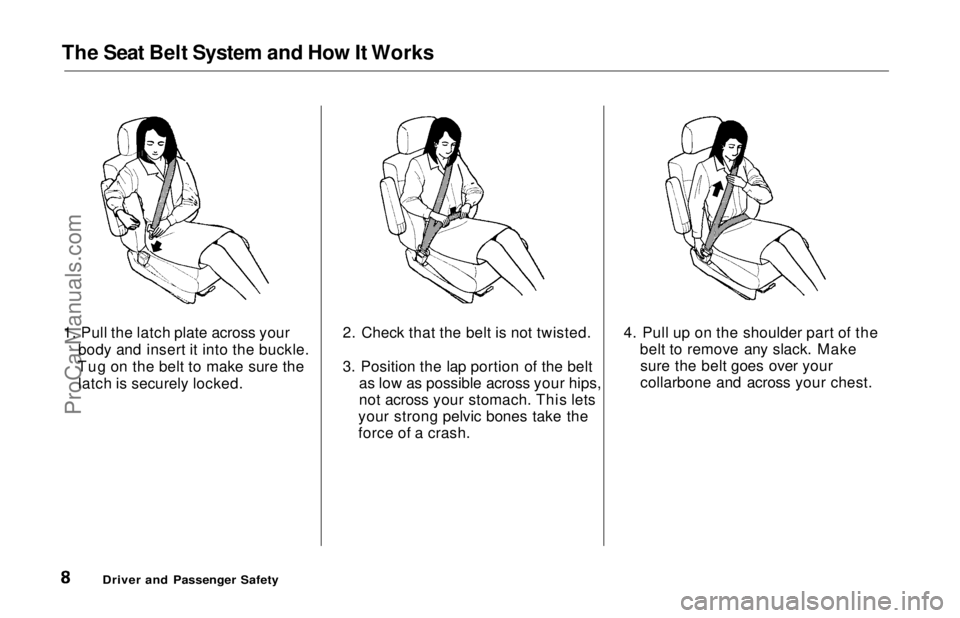
The Seat Belt System and How It Works
1. Pull the latch plate across your body and insert it into the buckle.
Tug on the belt to make sure the latch is securely locked. 2. Check that the belt is not twisted.
3. Position the lap portion of the belt
as low as possible across your hips,
not across your stomach. This lets
your strong pelvic bones take the
force of a crash. 4. Pull up on the shoulder part of the
belt to remove any slack. Makesure the belt goes over your
collarbone and across your chest.
Driver and Passenger SafetyProCarManuals.comMain Menu Table of Contents s t
Page 20 of 241
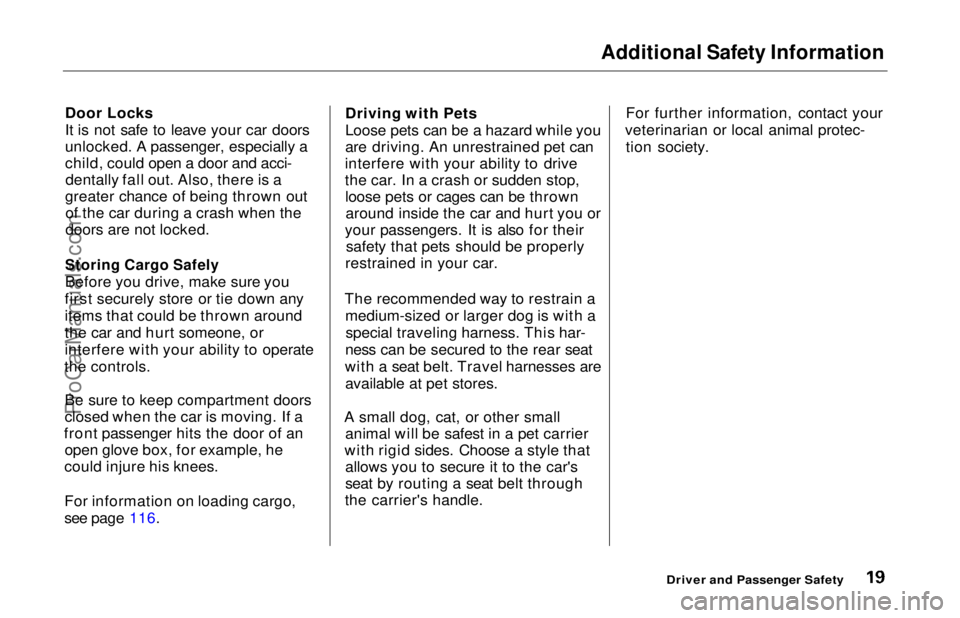
Additional Safety Information
Door Locks
It is not safe to leave your car doors
unlocked. A passenger, especially a
child, could open a door and acci- dentally fall out. Also, there is a
greater chance of being thrown out of the car during a crash when the
doors are not locked.
Storing Cargo Safely
Before you drive, make sure you
first securely store or tie down any
items that could be thrown around
the car and hurt someone, or
interfere with your ability to operate
the controls.
Be sure to keep compartment doors
closed when the car is moving. If a
front passenger hits the door of an open glove box, for example, he
could injure his knees.
For information on loading cargo,
see page 116. Driving with Pets
Loose pets can be a hazard while you
are driving. An unrestrained pet can
interfere with your ability to drive
the car. In a crash or sudden stop, loose pets or cages can be thrownaround inside the car and hurt you or
your passengers. It is also for their safety that pets should be properly
restrained in your car.
The recommended way to restrain a medium-sized or larger dog is with aspecial traveling harness. This har-
ness can be secured to the rear seat
with a seat belt. Travel harnesses are available at pet stores.
A small dog, cat, or other small animal will be safest in a pet carrier
with rigid sides. Choose a style that allows you to secure it to the car's
seat by routing a seat belt through
the carrier's handle. For further information, contact your
veterinarian or local animal protec- tion society.
Driver and Passenger SafetyProCarManuals.comMain Menu Table of Contents s t
Page 21 of 241
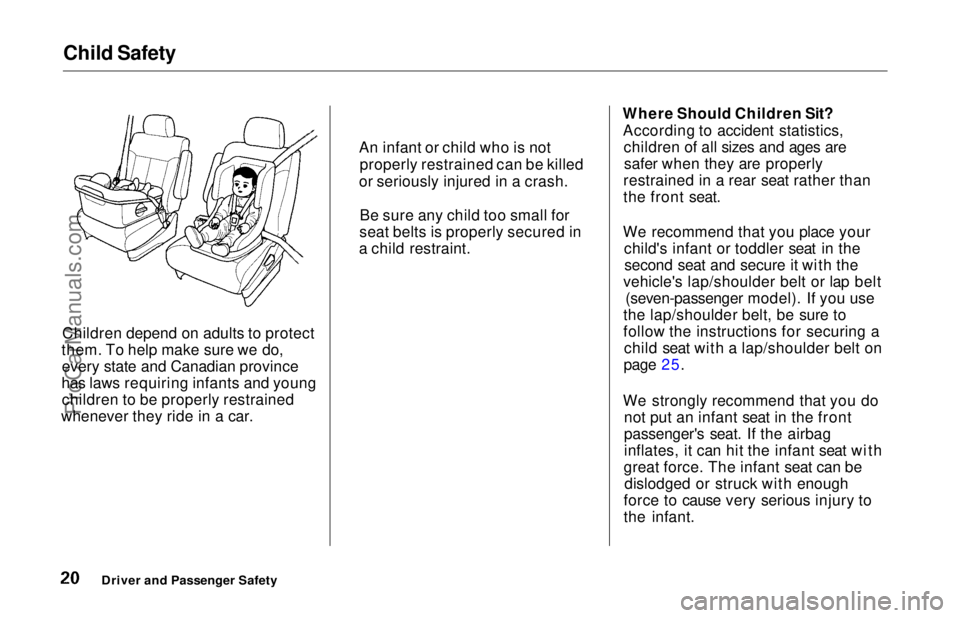
Child Safety
Children depend on adults to protect
them. To help make sure we do, every state and Canadian province
has laws requiring infants and young children to be properly restrained
whenever they ride in a car. Where Should Children Sit?
According to accident statistics, children of all sizes and ages aresafer when they are properly
restrained in a rear seat rather than
the front seat.
We recommend that you place your child's infant or toddler seat in thesecond seat and secure it with the
vehicle's lap/shoulder belt or lap belt (seven-passenger model). If you use
the lap/shoulder belt, be sure to
follow the instructions for securing a child seat with a lap/shoulder belt on
page 25.
We strongly recommend that you do not put an infant seat in the front
passenger's seat. If the airbag
inflates, it can hit the infant seat with
great force. The infant seat can be dislodged or struck with enough
force to cause very serious injury to
the infant.
Driver and Passenger Safety
An infant or child who is not
properly restrained can be killed
or seriously injured in a crash.
Be sure any child too small for
seat belts is properly secured in
a child restraint.ProCarManuals.comMain Menu Table of Contents s t
Page 23 of 241
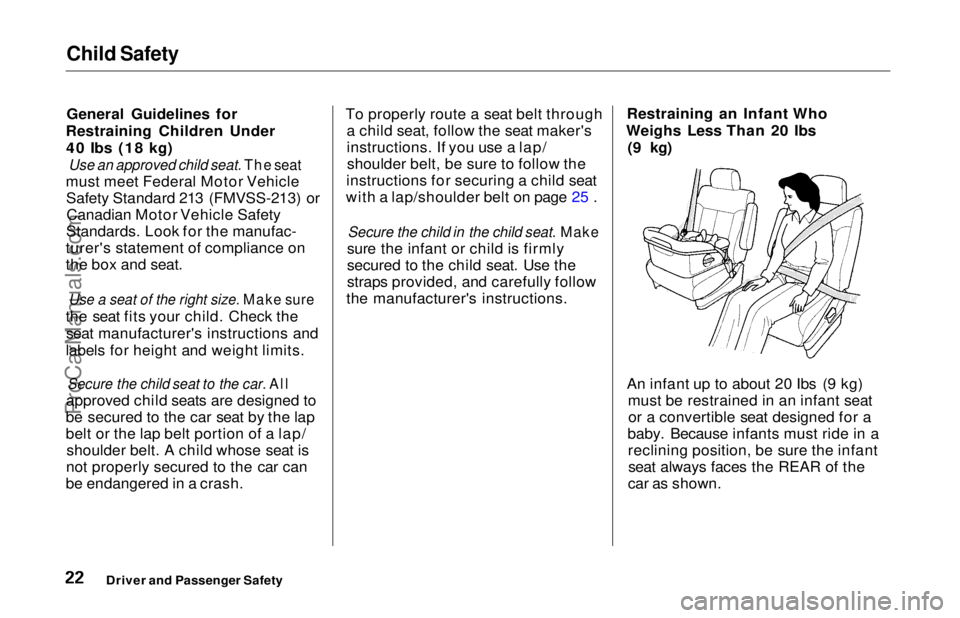
Child Safety
General Guidelines for
Restraining Children Under 40 Ibs (18 kg)
Use an approved child seat. The seat
must meet Federal Motor Vehicle Safety Standard 213 (FMVSS-213) orCanadian Motor Vehicle Safety
Standards. Look for the manufac-
turer's statement of compliance on
the box and seat.
Use a seat of the right size. Make sure
the seat fits your child. Check the seat manufacturer's instructions and
labels for height and weight limits.
Secure the child seat to the car. All
approved child seats are designed to
be secured to the car seat by the lap
belt or the lap belt portion of a lap/ shoulder belt. A child whose seat is
not properly secured to the car can
be endangered in a crash. To properly route a seat belt through
a child seat, follow the seat maker's
instructions. If you use a lap/shoulder belt, be sure to follow the
instructions for securing a child seat
with a lap/shoulder belt on page 25 .
Secure the child in the child seat. Make
sure the infant or child is firmly
secured to the child seat. Use the
straps provided, and carefully follow
the manufacturer's instructions. Restraining an Infant Who
Weighs Less Than 20 Ibs (9 kg)
An infant up to about 20 Ibs (9 kg) must be restrained in an infant seator a convertible seat designed for a
baby. Because infants must ride in a reclining position, be sure the infantseat always faces the REAR of the
car as shown.
Driver and Passenger SafetyProCarManuals.comMain Menu Table of Contents s t
Page 24 of 241
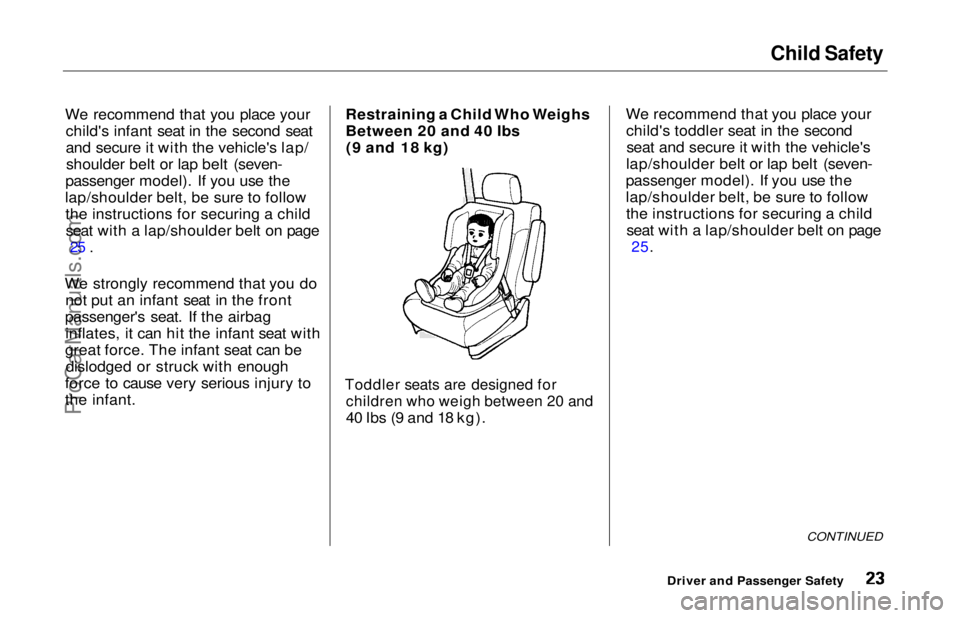
Child Safety
We recommend that you place your child's infant seat in the second seat
and secure it with the vehicle's lap/shoulder belt or lap belt (seven-
passenger model). If you use the
lap/shoulder belt, be sure to follow the instructions for securing a childseat with a lap/shoulder belt on page
25 .
We strongly recommend that you do not put an infant seat in the front
passenger's seat. If the airbag inflates, it can hit the infant seat with
great force. The infant seat can be dislodged or struck with enough
force to cause very serious injury to
the infant. Restraining a Child Who Weighs
Between 20 and 40 Ibs
(9 and 18 kg)
Toddler seats are designed for
children who weigh between 20 and
40 Ibs (9 and 18 kg). We recommend that you place your
child's toddler seat in the secondseat and secure it with the vehicle's
lap/shoulder belt or lap belt (seven-
passenger model). If you use the
lap/shoulder belt, be sure to follow the instructions for securing a childseat with a lap/shoulder belt on page
25.
CONTINUED
Driver and Passenger SafetyProCarManuals.comMain Menu Table of Contents s t